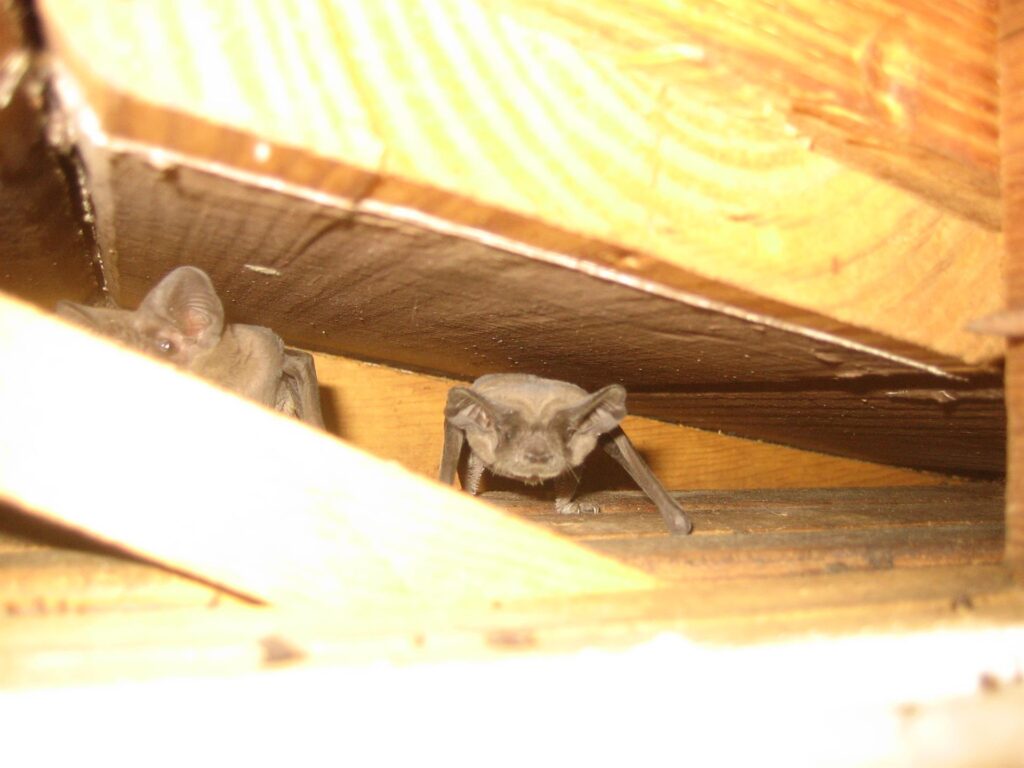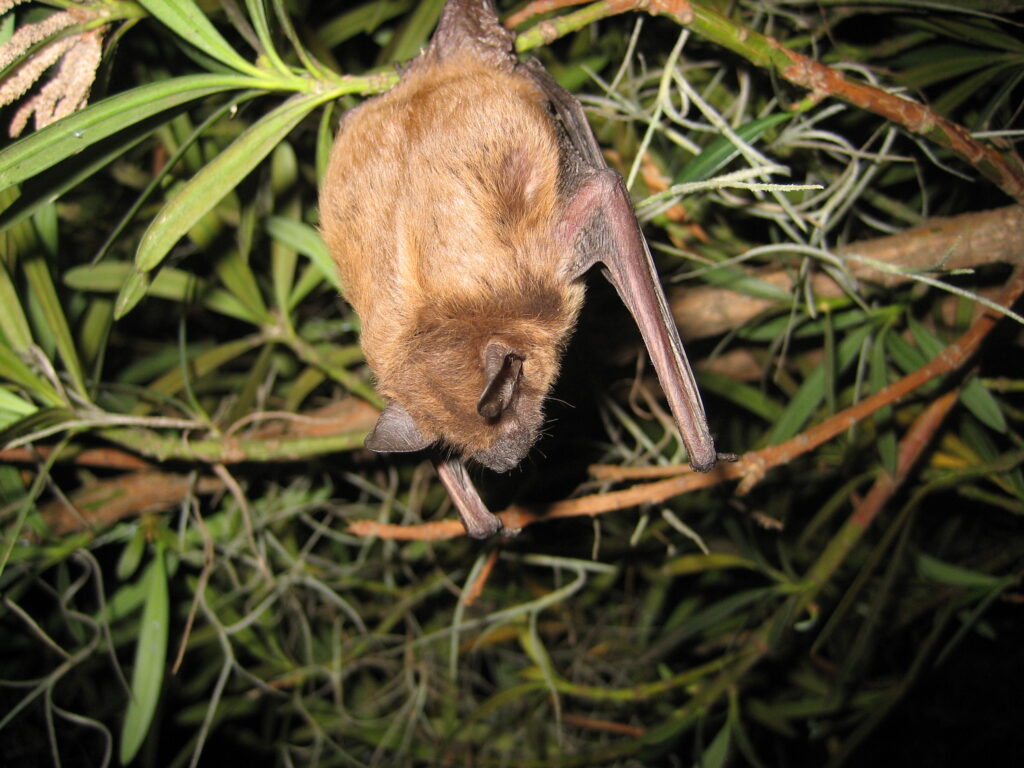
Call for Your Exclusive Wildlife Inspection Report.®
Effective Bat Removal
Bats are among the most-hated nuisance animals worldwide, as many people hate the appearance and disease-carrying capabilities of these winged creatures. Bats can be found carrying rabies, various coronaviruses, Marburg, Ebola, and many other diseases, making them a threat to humans. Continue reading to learn more about bats and how you can remove them as soon as possible.

What problems do bats cause?
Bats are a double-edged sword for humans, as they can spread serious diseases, and also cause property damage. Bats are one of the most diseased animals in the world. Some studies have shown that bats can carry over 120 different viruses and bacteria at any given time. While bats can carry Ebola, coronaviruses, Marburg, and other very serious diseases, the odds of encountering this in the United States are very low. Rabies can be commonly found in United States bats, however, making it a very serious problem. Since bats do not just spread diseases through bites, it is important to realize that they can also be spread through their feces and urine.
Bats can find a way into almost any structure, particularly in older homes and buildings. If they can find a way, bats love to get into attics of homes and buildings. When they begin nesting here, they will leave a large mess of feces all over your attic. These feces can not only spread diseases all over but also can ruin and stain your insulation. Since bat feces are corrosive, they can cause the weakening of metal structures as well, potentially causing large repair bills. Between damage and health risks, bats are a very important animal to remove as soon as possible.
Why are bats attracted to my property?
Bats can be found in many places around the world, but there are two main requirements they have when it comes to finding a suitable area to live in. The first, most important of these is an abundance of food. Wherever bats can find areas that have very high insect populations, they will likely stick around. In addition to food requirements, bats also need shelter. Bats often prefer wooded areas, homes, or barns where they can roost and nest, raising their young.
Bats particularly love making their way into homes, as buildings provide excellent shelter that will keep bats safe and warm in virtually any condition. And what better place in a house for a bat than the attic? Attics are dark, out-of-the-way parts of homes that provide everything a bat needs. The insulation in the attic is often used by bats to nest their young, and they can multiply in homes very quickly. This makes it especially important to keep bats out of your home and remove them as soon as possible if they make their way in.
How can I prevent bats?
Bats, much like rats and mice, have the ability to get into the smallest of cracks, gaps, and holes that are commonly found on people’s buildings. One of the best ways to get rid of these access points is by examining your home’s exterior and interior. You are looking for any holes or other entry points that could allow bats access. Inspect your roof, attic, and roofline with great attention to detail, as these are some of the most common problem areas. If you find any concerning entry points, be sure to repair them. Many people use all-weather sealant on many of the cracks they find, but aluminum sheeting and treated lumber work in many scenarios as well. To keep bats out of your roof, you can use a mesh fencing material that does not allow them access, or you could reshingle if your roof is in bad shape anyway.
Another important part of your home to be sure to examine is your chimney. Chimneys provide bats with an easy access point that could potentially lead to them getting inside. One of the best things you can do is to install a chimney guard or a chimney cap. These are covers that let the smoke through, but prevent nuisance animals from gaining access to your chimney. These work to keep bats, birds, rats and mice, squirrels, and raccoons out!

How do I remove bats?
Simply put, the removal of bats should be left to professional wildlife removal companies. Bats are very important to Nature, as they eat massive amounts of harmful insects, such as mosquitoes and moths. In addition to the need to keep these critters safe, they can also be extremely hazardous to remove, as they can easily spread disease to humans and their families. If the bats are an isolated problem, you could try to use a one-way door that lets bats out but not back in, as this is a humane and safe way to remove bats. At the end of the day, the best option is to leave the removal of bats to professionals, as it often ends up being more economical anyways.
Why hire Wildlife X Team Nashville?
Here at Wildlife X Team Nashville, we pride ourselves on removing bats from your home while keeping you and your family safe. Our experts have years of experience with removing bats, as well as other nuisance animals in a humane and effective way. Not only do we remove wildlife, but we also offer animal damage repair, attic restoration, cleanup, and odor elimination, as well as many other services. If you have bats that you want going, give us a call here at Wildlife X Team Nashville today!

How to Get Bats Out of a Wall?
Bats are a very essential part of the ecosystem, they help to control the population of insects and bugs. These flying mammals are recognized as important and several species are protected by laws, but no one wants to share a roof with them. When bats get into your home, they can cause damages worth several hundred dollars. Finding bats in your home is a major concern because it can be difficult to evict them, especially if they have been there for a long time. Bats in your walls is a problem best left to bat control experts, but if you want to try DIY bat removal, here are the steps to follow.
Do a thorough inspection
A thorough inspection to determine the exact areas where the bats are hiding will give a good idea of where to focus during the eviction. You have to follow the noises coming from the walls to determine exactly where the bats are, plus you also have to find out how they are getting into the walls.
If bats are inside your walls, it’s because there is a hole somewhere through which they are getting into the walls. If you want to find that hole or holes, this is the key to getting them out of the wall. Bats are nocturnal animals and will fly out at dusk to hunt, they return to their roost at dawn to sleep throughout the day.
An easy way to find out how the bats are getting in is to closely monitor their movement, you actually want to do this from a safe distance. Take your time to observe them as they exit the wall at dusk to forage, take note of the areas where they are crawling out from, and take pictures or make videos if you have to, this will help you find their entry point much faster.
Install a one-way door
If there is more than one entry point, then you will have to identify the major entrance and seal off the rest. Next, install a one-way door on the major entrance. Do this during the day when you know that the bats are all inside the wall. The one-way bat exclusion door will enable the bats to safely fly out of the wall, but they will be unable to get back inside.
Once they fly out the next evening, that will be the last time they return to your walls. Note that it may take a few days for all the bats to leave. Don’t rush to seal the last hole yet, give them a few to leave completely, and continue to monitor the one-way door as you do so. Watch for any signs of bats leaving and check the walls for bat noises to make sure that no animal is stuck in there. If you have confirmed that they are all gone, you can proceed to remove the one-way door and seal off the last hole.
Clean up and sanitize
There is always some amount of guano with every bat infestation, and this needs to be cleaned out after the bats are gone. Bat guano is toxic and can corrode both wood and metal, they also harbor the spores of the fungus that is responsible for histoplasmosis, a fungal disease that affects the respiratory system.
Cleaning up bat feces has to be done very carefully to prevent infection, you have to wear gloves, nose masks, cover all, and use a high-power vacuum cleaner to vacuum the waste. The vacuumed waste also has to be properly disposed of to prevent the spread of disease, finally, use a powerful fungicide to disinfect your home.
Get professional assistance
Getting bats out of the wall is a job best left to professionals. There are local laws that protect some bat species, and you have to be licensed to handle bat evictions. Getting professional help is always the smart thing to do when it comes to wildlife removal, risking your health and that of your family is really not worth it. The experts at Critter Pro in Jacksonville, Florida, are prepared to handle any bat infestations safely while working hard to protect your home and the people in it.
Get Quote for Your Exclusive Wildlife Inspection Report.®





